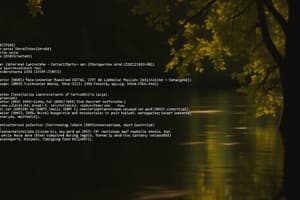Podcast
Questions and Answers
What is the primary purpose of an algorithm?
What is the primary purpose of an algorithm?
- To complicate the solution to a problem.
- To limit the understanding of a solution to a specific programming language.
- To make problems unsolvable in a finite amount of time.
- To define a sequence of steps that leads to a desired answer. (correct)
Which of the following is NOT a characteristic of an algorithm?
Which of the following is NOT a characteristic of an algorithm?
- The sequence of steps is ambiguous. (correct)
- Each step can be done in a finite amount of time.
- Each step is a clear instruction.
- The process stops after a finite number of steps.
What is the purpose of pseudocode in algorithm design?
What is the purpose of pseudocode in algorithm design?
- To directly translate an algorithm into a specific computer language.
- To limit the algorithm's applicability to only one specific language.
- To generalize the algorithm in an English-like format before coding. (correct)
- To complicate the algorithm so it's harder to understand.
In a flowchart, which symbol represents a decision?
In a flowchart, which symbol represents a decision?
Which flowchart symbol represents the start or end of an algorithm?
Which flowchart symbol represents the start or end of an algorithm?
What does the 'finiteness' property of an algorithm refer to?
What does the 'finiteness' property of an algorithm refer to?
What is the purpose of 'control structures' in algorithms?
What is the purpose of 'control structures' in algorithms?
Which type of control structure involves setting a condition for the execution of an algorithm step?
Which type of control structure involves setting a condition for the execution of an algorithm step?
In the context of algorithms, what does 'generality' refer to?
In the context of algorithms, what does 'generality' refer to?
What is the role of 'arrows' in a flowchart?
What is the role of 'arrows' in a flowchart?
What does 'tracing an algorithm' involve?
What does 'tracing an algorithm' involve?
What is the purpose of a loop control structure in an algorithm?
What is the purpose of a loop control structure in an algorithm?
In the given pseudocode example for finding the minimum value in a sequence, what is the initial assumption made?
In the given pseudocode example for finding the minimum value in a sequence, what is the initial assumption made?
Which property ensures that an algorithm produces correct output values for each set of input values?
Which property ensures that an algorithm produces correct output values for each set of input values?
What does 'Effectiveness' of an algorithm imply?
What does 'Effectiveness' of an algorithm imply?
Consider an algorithm that calculates the square root of a number. If the algorithm only works for integers, which property is it violating if applied to a decimal number?
Consider an algorithm that calculates the square root of a number. If the algorithm only works for integers, which property is it violating if applied to a decimal number?
In the if-then-else control structure, what happens if the condition is false?
In the if-then-else control structure, what happens if the condition is false?
What is the primary purpose of tracing an algorithm?
What is the primary purpose of tracing an algorithm?
In the for-do loop control structure, what determines the number of times a step will be executed?
In the for-do loop control structure, what determines the number of times a step will be executed?
Why is it important for an algorithm to have 'definiteness'?
Why is it important for an algorithm to have 'definiteness'?
In the context of algorithms, what is the significance of the 'output' property?
In the context of algorithms, what is the significance of the 'output' property?
Which control structure is best suited for executing a block of code as long as a certain condition remains true?
Which control structure is best suited for executing a block of code as long as a certain condition remains true?
What is the key difference between a while-do loop and a repeat-until loop?
What is the key difference between a while-do loop and a repeat-until loop?
If an algorithm is 'ineffective', what is the most likely cause?
If an algorithm is 'ineffective', what is the most likely cause?
Given an algorithm that is designed to sort a list of numbers but fails to correctly sort a list containing duplicate values, which property does the algorithm most likely violate?
Given an algorithm that is designed to sort a list of numbers but fails to correctly sort a list containing duplicate values, which property does the algorithm most likely violate?
Consider an algorithm designed to find the shortest path between two cities. However, the algorithm only considers direct routes and ignores connecting routes. Which property of algorithms is most clearly being violated?
Consider an algorithm designed to find the shortest path between two cities. However, the algorithm only considers direct routes and ignores connecting routes. Which property of algorithms is most clearly being violated?
In an algorithm, a step is described as 'Go back to step X'. What potential issue might this introduce?
In an algorithm, a step is described as 'Go back to step X'. What potential issue might this introduce?
Suppose you have an algorithm to calculate the area of a circle, but the step involving the value of Pi ($\pi$) is defined as 'approximately 3'. Which property of algorithms does this undermine, and why?
Suppose you have an algorithm to calculate the area of a circle, but the step involving the value of Pi ($\pi$) is defined as 'approximately 3'. Which property of algorithms does this undermine, and why?
An algorithm is designed to search for a specific name in a phone book. If the algorithm checks every single entry in the phone book, regardless of whether it has found the name or not, which property is least efficiently addressed?
An algorithm is designed to search for a specific name in a phone book. If the algorithm checks every single entry in the phone book, regardless of whether it has found the name or not, which property is least efficiently addressed?
What is the most significant limitation of using pseudocode to represent an algorithm?
What is the most significant limitation of using pseudocode to represent an algorithm?
Consider a flowchart where the arrow indicating the flow of an algorithm suddenly stops without connecting to any other symbol. What issue does this represent?
Consider a flowchart where the arrow indicating the flow of an algorithm suddenly stops without connecting to any other symbol. What issue does this represent?
If an algorithm produces a correct output, but takes an exponentially increasing amount of time to do so as the input size grows, which property should be improved?
If an algorithm produces a correct output, but takes an exponentially increasing amount of time to do so as the input size grows, which property should be improved?
An algorithm's description states 'Repeat steps 1-5 until the result is satisfactory'. What critical flaw does this description contain?
An algorithm's description states 'Repeat steps 1-5 until the result is satisfactory'. What critical flaw does this description contain?
Suppose an algorithm is designed to manage financial transactions, but it fails to handle transactions involving negative amounts correctly, leading to incorrect balances. Which property of algorithms is most directly violated?
Suppose an algorithm is designed to manage financial transactions, but it fails to handle transactions involving negative amounts correctly, leading to incorrect balances. Which property of algorithms is most directly violated?
Imagine an algorithm described as 'Do the following steps quickly.' Which core property of a well-defined algorithm is most clearly missing?
Imagine an algorithm described as 'Do the following steps quickly.' Which core property of a well-defined algorithm is most clearly missing?
You have devised an algorithm that solves a specific problem efficiently. However, it can only be understood and executed by a single person who created it because the steps are based on their intuition. While 'finiteness' and 'correctness' are satisfied, which crucial attribute is most lacking?
You have devised an algorithm that solves a specific problem efficiently. However, it can only be understood and executed by a single person who created it because the steps are based on their intuition. While 'finiteness' and 'correctness' are satisfied, which crucial attribute is most lacking?
An AI algorithm is designed to filter email spam. Over time, it starts incorrectly classifying important emails as spam because it has adapted too closely to the characteristics of past spam messages. Which aspect of algorithm design does this scenario highlight a failure in?
An AI algorithm is designed to filter email spam. Over time, it starts incorrectly classifying important emails as spam because it has adapted too closely to the characteristics of past spam messages. Which aspect of algorithm design does this scenario highlight a failure in?
Flashcards
Algorithm
Algorithm
A finite sequence of well-defined steps to perform a task.
Pseudocode
Pseudocode
An intermediate step between English and a specific computer language.
Flowchart
Flowchart
A diagram to aid in the visualization of a program.
Start/Stop Symbol
Start/Stop Symbol
Signup and view all the flashcards
Process Symbol
Process Symbol
Signup and view all the flashcards
Decision Symbol
Decision Symbol
Signup and view all the flashcards
Input/Output Symbol
Input/Output Symbol
Signup and view all the flashcards
Arrows in Flowcharts
Arrows in Flowcharts
Signup and view all the flashcards
Input Value
Input Value
Signup and view all the flashcards
Output Value
Output Value
Signup and view all the flashcards
Definiteness
Definiteness
Signup and view all the flashcards
Correctness
Correctness
Signup and view all the flashcards
Finiteness
Finiteness
Signup and view all the flashcards
Effectiveness
Effectiveness
Signup and view all the flashcards
Generality
Generality
Signup and view all the flashcards
Control Structures
Control Structures
Signup and view all the flashcards
Conditional Controls
Conditional Controls
Signup and view all the flashcards
Loop Controls
Loop Controls
Signup and view all the flashcards
Tracing an Algorithm
Tracing an Algorithm
Signup and view all the flashcards
Study Notes
Algorithms
- Algorithms are finite sequences of well-defined steps.
- The steps are clear instructions, executable in a finite amount of time.
- The sequence of steps is clear, and the process stops after a finite number of steps.
- Algorithms provide a method or procedure to solve a mathematical problem.
Algorithm Example: Finding the Least Number in a Set
- Problem: Find the least number in the set {3, 5, 6, 1, 2, 7}.
- The algorithm compares each number to the previous, keeping the lesser value.
- Stepwise comparison identifies 1 as the least number.
Pseudocode
- Pseudocode simplifies algorithms, avoiding the complexities and limitations of computer languages.
- It serves as an intermediate step, translating an algorithm from English to a specific computer language.
Pseudocode Example: Finding the Minimum Value in a Sequence
- Procedure:
min(a1, a2, a3, ..., an : integers) - Initialize
minto the first element, a1. - Iterate through the remaining elements:
for i := 2 to n - If a current element
aiis less thanmin, updatemintoai. - Return the
minvalue, representing the smallest element.
Flowchart
- Flowcharts visually represent algorithms.
- They are read from top to bottom and left to right.
- Start/Stop: marks the beginning and end of the code
- Process: This is an instruction that is carried out by the program
- Decision: Splits the flow into multiple paths for selection and repetition.
- Input/Output: Represents the data entry or display of data by the program.
- Arrows: Arrows indicate the flow of the algorithm.
Algorithm Properties
- Input: Algorithms take input values from a specified set.
- Output: Algorithms produce output values (solutions) from input values.
- Definiteness: Algorithm steps must be precisely defined.
- Correctness: Algorithms must produce correct output values for each input.
- Finiteness: Algorithms must produce the desired output after a finite number of steps for any input.
- Effectiveness: Each algorithm step must be executable exactly in a finite time.
- Generality: Algorithms should be applicable to all problems of the desired form, not just specific inputs.
Control Structures
- Control structures dictate what commands to execute, when, and how.
Conditional Controls
- Conditional controls set conditions for algorithm step execution, such as if-then statements.
- Example: Determining if a student passed based on their score involves an if-then conditional: if the score is 60 or higher, output "Passed".
- An if-then-else structure can be used to output "Passed" if the score is at least 60, and "Failed" otherwise.
Loop Controls
- These controls determine how many times to execute a step.
- Example in finding the least number: inputting the number of elements
n, the elementsx1, x2, …, xn, settingmintox1, and iterating to find a smaller value.- The
for-doloop iterates through elements to find the minimum. - The
while-doloop continues as long as a condition is met such as finding the order of the factor two for a given integer n. - The
repeat-untilloop continues until a condition is met like listing integers from n to 1.
- The
Tracing Algorithms
- Tracing involves manually following algorithm steps to generate a result.
- It is useful for testing consistency and identifying errors.
- A table tracks steps, inputs, variables, and outputs during tracing.
Studying That Suits You
Use AI to generate personalized quizzes and flashcards to suit your learning preferences.




